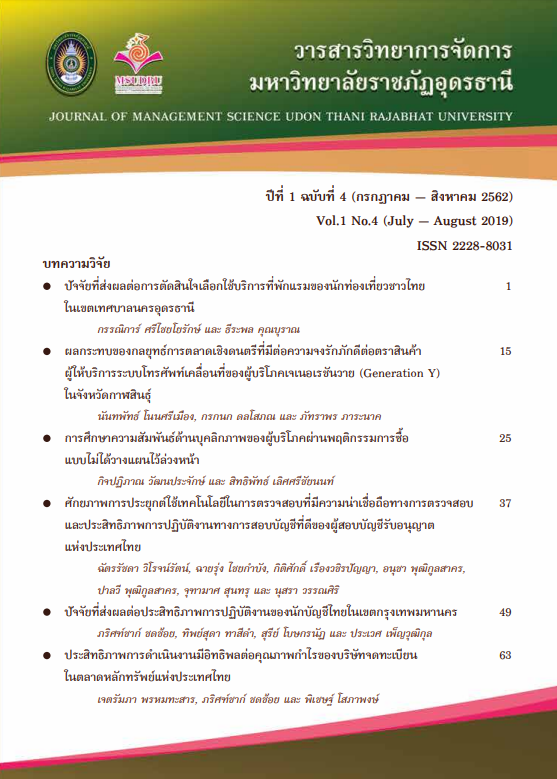ศักยภาพการประยุกต์ใช้เทคโนโลยีในการตรวจสอบที่มีความน่าเชื่อถือทางการตรวจสอบและประสิทธิภาพการปฏิบัติงานทางการสอบบัญชีที่ดีของผู้สอบบัญชีรับอนุญาตแห่งประเทศไทย
Main Article Content
บทคัดย่อ
การวิจัยครั้งนี้มีวัตถุประสงค์เพื่อศึกษา ผลกระทบของศักยภาพการประยุกต์ใช้เทคโนโลยีในการตรวจสอบ ที่มีต่อความน่าเชื่อถือทางการตรวจสอบและประสิทธิภาพในการปฏิบัติงานทางการสอบบัญชีที่ดีของผู้สอบบัญชีรับอนุญาตแห่งประเทศไทย โดยใช้แบบสอบถามเป็นเครื่องมือ ในการเก็บข้อมูลจากผู้สอบบัญชีรับอนุญาตแห่งประเทศไทย จำนวน 432 ราย สถิติที่ใช้ ได้แก่ การวิเคราะห์ถดถอยพหุคูณ (Multiple Regression analysis) ผลการวิจัยพบว่า ศักยภาพการประยุกต์ใช้เทคโนโลยีในการตรวจสอบทุกมิติมีผลกระทบเชิงบวกกับความน่าเชื่อถือทางการตรวจสอบ และความน่าเชื่อถือทางการตรวจสอบมีผลกระทบเชิงบวกกับประสิทธิภาพการปฏิบัติงานทางการสอบบัญชีที่ดี
Article Details

อนุญาตภายใต้เงื่อนไข Creative Commons Attribution-NonCommercial-NoDerivatives 4.0 International License.
บทความที่ได้รับการตีพิมพ์เป็นลิขสิทธิ์ของคณะวิทยาการจัดการ มหาวิทยาลัยราชภัฏอุดรธานี
ข้อความที่ปรากฏในบทความแต่ละเรื่องในวารสารวิชาการเล่มนี้
ไม่ใช่ความคิดเห็นและความรับผิดชอบของผู้จัดทำ บรรณาธิการ กองบรรณาธิการ และคณะวิทยาการจัดการ มหาวิทยาลัยราชภัฏอุดรธานี ความรับผิดชอบด้านเนื้อหาและการตรวจร่างบทความแต่ละเรื่องเป็นความคิดเห็นของผู้เขียนบทความแต่ละท่าน
เอกสารอ้างอิง
สภาวิชาชีพบัญชี ในพระบรมราชูปถัมภ์. (2561). ข้อมูลติดต่อผู้สอบบัญชี. สืบค้นเมื่อ 10 พฤศจิกายน 2561, จาก https://eservice.fap.or.th/fap_registration/cpa-contact-list?condition=4&district_hidden=&province_hidden=&geography_hidden.
Aaker, D. A., Kumar, V. & Day, G. S. (2001). Marketing research. (7th ed.). New York: John Wiley & Sons.
Armstrong, J. S., and Overton, T. S. (1977). Estimating Non-Response Bias in Mail Surveys. Journal of Marketing Research, Vol. 14, 396-402.
Bryer, A. R. (2014). Conscious practices and purposive action: A qualitative study of accounting and social change. Critical Perspectives on Accounting, 25(2), 93-103.
Cronbach, L. J. (1954). Educational psychology. Oxford, England: Harcourt, Brace.
Curtis, M. B., & Payne, E. A. (2008). An examination of contextual factors and individual characteristics expecting technology implementation decisions in auditing. International Journal of Accounting Information Systems, 9(1), 104-121.
Duggan, G. B. (2016). Applying psychology to understand relationships with technology: from ELIZA to interactive healthcare. Behavior & Information Technology, 35(7), 536-547.
Hair, J. F., Black, W. C., Babin, B. J., & Anderson, R. E. (2010). Multivariate Data Analysis. (7th Ed.). New Jersey: Prentice Hall, Upper Saddle River.
Ireland, R. D., Hitt, M. A., & Vaidyanath, D. (2002). Alliance management as a source of competitive advantage. Journal of Management, 28(3), 413-446.
Likert, Rensis. (1967). “The Method of Constructing and Attitude Scale”. In Reading in Fishbeic, M (Ed.), Attitude Theory and Measurement. New York: Wiley & Sons.
Llias, A., Razek, M. Z. A., Yasoa, M. R., & Mansor, N. H. A. (2010). The critical factors in determining end-user computing satisfaction (euos) in computerized accounting system (oas): A practice in private sectors in LABUAN F.T. Unitar E- Journal, 6(1), 27-37.
Peek, R. M., Fiske, C., & Wilson, K. T. (2010). Role of innate immunity in Helicobacter pylori-induced gastric malignancy. Physiological Reviews, 90(3), 831-858.
Yamane, T. (1973). Statistics: An Introductory Analysis. (3rd ed.). New York: Horper and Row.


